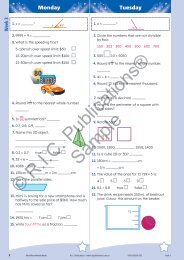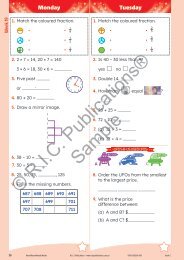You also want an ePaper? Increase the reach of your titles
YUMPU automatically turns print PDFs into web optimized ePapers that Google loves.
Major climate <strong>zones</strong> of the world<br />
Lesson objectives<br />
XXIdentifying the difference between weather and climate, and how weather contributes to climate<br />
XXIdentifying and locating four major climate <strong>zones</strong> of the world (Tropical, Subtropical, Temperate and Polar <strong>zones</strong>) and<br />
describing the characteristics of each<br />
Lesson plan<br />
Introduction<br />
XXDisplay current weather information for countries around the<br />
world at . Discuss the information<br />
presented including the date and time, the weather symbols and<br />
the temperature.<br />
Development<br />
XXAs a class, watch the video at to<br />
identify the difference between weather and climate. Students use<br />
a note-taking app (Notes) to record a definition of each word.<br />
XXStudents scan the QR codes or use the URLs on page 25 to learn<br />
about the world’s major climate <strong>zones</strong>. Students map the location<br />
of the four major <strong>zones</strong> and provide a key explaining the map<br />
markings (colouration or symbols) used. They then watch a video<br />
about the classification of climate <strong>zones</strong> and record key information<br />
about each climate zone’s characteristics on page 25.<br />
XXStudents use the same note-taking app used previously to write<br />
five quiz questions about the location or characteristics of the<br />
four major climate <strong>zones</strong> and record the answer to each question.<br />
Note: Students should base their quiz questions on the information<br />
presented in the video.<br />
XXStudents use a presentation app (Microsoft PowerPoint) to explain<br />
the four major climate <strong>zones</strong> of the world. Students will need to<br />
include a definition of climate, a photograph of their completed<br />
map and an explanation of the characteristics of each major<br />
zone. Students then add their quiz questions and answers to the<br />
presentation.<br />
Conclusion<br />
XXIn pairs, students examine their completed copies of page 25 to<br />
discuss patterns in the location or characteristics of the four major<br />
climate <strong>zones</strong>, and compare the climate <strong>zones</strong> of countries they<br />
are familiar with. Prompt students discussion by asking What<br />
patterns can you see between the climate <strong>zones</strong> in the northern<br />
and southern hemispheres? Which countries have a similar climate<br />
to Australia?<br />
Resources<br />
XXWorld temperatures—Weather around<br />
the world<br />
<br />
XXVideo—Weather and climate<br />
<br />
XXiPad ® /tablet with QR scanner, a notetaking<br />
app (Notes) and a presentation<br />
app (Microsoft PowerPoint)<br />
XXPage 25<br />
Travelling further<br />
As a class, use the climate time<br />
machine at to explore the<br />
world’s changing climate.<br />
Students research climate<br />
change to create an infographic<br />
about the effects of climate<br />
change and then create a video<br />
proposing actions to reduce<br />
climate change.<br />
Curriculum links<br />
HASS Knowledge and Understanding<br />
The main climate types of the world and the similarities and differences between the climates of different places<br />
(ACHASSK068)<br />
HASS Inquiry and Skills<br />
Questioning Researching Analysing<br />
Evaluating and<br />
reflecting<br />
Communicating<br />
• Poses questions relating<br />
to the location and<br />
characteristics of the world’s<br />
four major climate <strong>zones</strong> to<br />
create a quiz<br />
• Locates and collects<br />
information websites, maps<br />
and videos<br />
• Records, sorts and<br />
represents data on a map<br />
and using a note-taking app<br />
• Interprets information<br />
on a map to identify the<br />
countries located in each<br />
climate zone<br />
• Identifies pattens between<br />
climate <strong>zones</strong> in the<br />
northern and southern<br />
hemispheres<br />
• Draws conclusions about<br />
the weather and climate<br />
in Australia and other<br />
countries to find similarities<br />
and differences<br />
• Communicates<br />
understanding using a<br />
presentation app<br />
24Y<strong>Year</strong> 3A AC GLOBAL GEOGRAPHYw www.ricpublications.com.auI


















